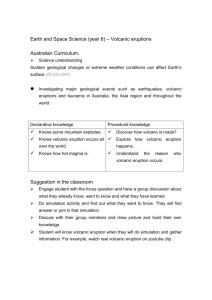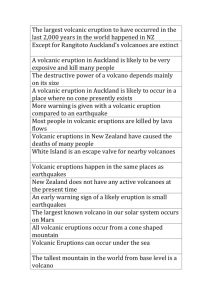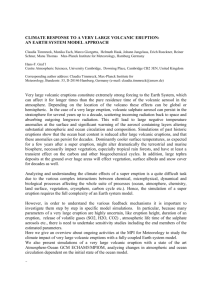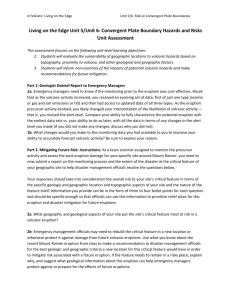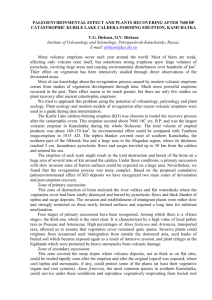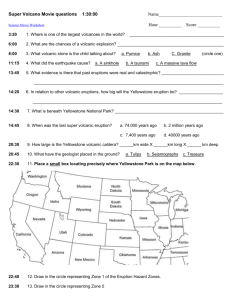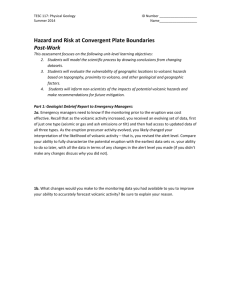Brand Syllabus 2014 Without Dates
advertisement
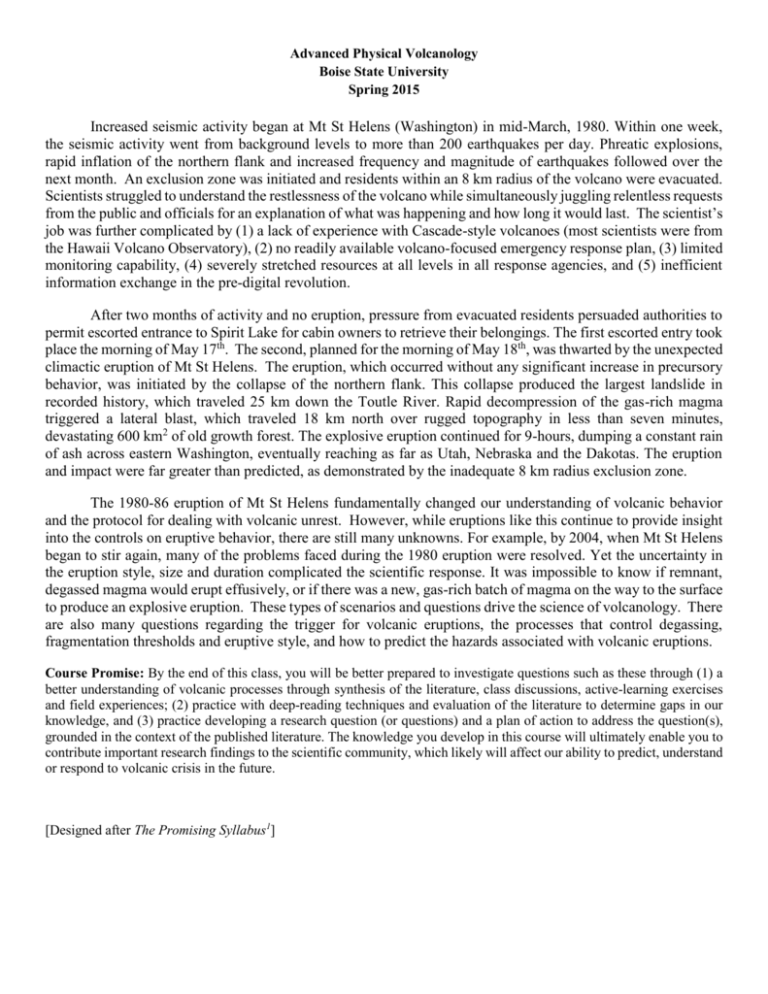
Advanced Physical Volcanology Boise State University Spring 2015 Increased seismic activity began at Mt St Helens (Washington) in mid-March, 1980. Within one week, the seismic activity went from background levels to more than 200 earthquakes per day. Phreatic explosions, rapid inflation of the northern flank and increased frequency and magnitude of earthquakes followed over the next month. An exclusion zone was initiated and residents within an 8 km radius of the volcano were evacuated. Scientists struggled to understand the restlessness of the volcano while simultaneously juggling relentless requests from the public and officials for an explanation of what was happening and how long it would last. The scientist’s job was further complicated by (1) a lack of experience with Cascade-style volcanoes (most scientists were from the Hawaii Volcano Observatory), (2) no readily available volcano-focused emergency response plan, (3) limited monitoring capability, (4) severely stretched resources at all levels in all response agencies, and (5) inefficient information exchange in the pre-digital revolution. After two months of activity and no eruption, pressure from evacuated residents persuaded authorities to permit escorted entrance to Spirit Lake for cabin owners to retrieve their belongings. The first escorted entry took place the morning of May 17th. The second, planned for the morning of May 18th, was thwarted by the unexpected climactic eruption of Mt St Helens. The eruption, which occurred without any significant increase in precursory behavior, was initiated by the collapse of the northern flank. This collapse produced the largest landslide in recorded history, which traveled 25 km down the Toutle River. Rapid decompression of the gas-rich magma triggered a lateral blast, which traveled 18 km north over rugged topography in less than seven minutes, devastating 600 km2 of old growth forest. The explosive eruption continued for 9-hours, dumping a constant rain of ash across eastern Washington, eventually reaching as far as Utah, Nebraska and the Dakotas. The eruption and impact were far greater than predicted, as demonstrated by the inadequate 8 km radius exclusion zone. The 1980-86 eruption of Mt St Helens fundamentally changed our understanding of volcanic behavior and the protocol for dealing with volcanic unrest. However, while eruptions like this continue to provide insight into the controls on eruptive behavior, there are still many unknowns. For example, by 2004, when Mt St Helens began to stir again, many of the problems faced during the 1980 eruption were resolved. Yet the uncertainty in the eruption style, size and duration complicated the scientific response. It was impossible to know if remnant, degassed magma would erupt effusively, or if there was a new, gas-rich batch of magma on the way to the surface to produce an explosive eruption. These types of scenarios and questions drive the science of volcanology. There are also many questions regarding the trigger for volcanic eruptions, the processes that control degassing, fragmentation thresholds and eruptive style, and how to predict the hazards associated with volcanic eruptions. Course Promise: By the end of this class, you will be better prepared to investigate questions such as these through (1) a better understanding of volcanic processes through synthesis of the literature, class discussions, active-learning exercises and field experiences; (2) practice with deep-reading techniques and evaluation of the literature to determine gaps in our knowledge, and (3) practice developing a research question (or questions) and a plan of action to address the question(s), grounded in the context of the published literature. The knowledge you develop in this course will ultimately enable you to contribute important research findings to the scientific community, which likely will affect our ability to predict, understand or respond to volcanic crisis in the future. [Designed after The Promising Syllabus1] Brand GEOS 597-006 2015 SYLLABUS: GEOS-597 Advanced Physical Volcanology TuTh 3-4:15 pm Instructor: Dr. Brittany Brand, brittanybrand@boisestate.edu Office hours: Thursday 1-2 pm (or by appointment) ERB 5163 Course Description: Students will apply field and numerical techniques to understand the physical processes driving magmatism and volcanic eruptions. Topics may include the generation, storage and evolution of magma through to eruptive dynamics. Two full-day field trips are required (may include an overnight trip). Prerequisites include MATH 175 and GEOS 460/560. Learning is the act of seeking new knowledge, or modifying, improving or reinforcing existing knowledge. Learning is active – it requires the learner to construct, personalize and pursue knowledge in a way that works best for them. You are entering a learning-centered environment1, where both the learner and the instructor have important responsibilities: Student Responsibilities Take control of your learning Participate in collaborative learning Spend time learning outside of the classroom Learn new “how-to-learn” strategies Engage in reflection exercises (early and often) Participate in class Solve problems using (and developing) critical thinking skills Evaluate your peer’s writing and your own writing Provide constructive, thorough peer review for your classmates Complete required reading and assignments Provide critical feedback to the instructor on the methods that facilitate your learning throughout the course Adapted from: Doyle, T. (2008). Instructor Responsibilities Clearly communicate expectations Effectively manage class time Provide structure, but with flexibility Make sure the course is relevant to the learners Assess and evaluate learning Facilitate shared decision making Provide prompt and useful feedback Interact with learners inside and outside of the classroom Provide opportunities for active learning Provide tools and opportunities for critical thinking Provide feedback and direction to facilitate learning, but largely allow learners to be responsible for their own learning Respect learners Learning Goals: Through class activities, discussions and presentations, students will demonstrate their ability to evaluate, synthesize and communicate how material properties and physical processes control volcanic eruptions. Students will demonstrate an analysis and synthesis of controversial topics in physical volcanology through Monte Carlo quizzes, discussions and debates of the relevant literature. Students will demonstrate their ability to observe and interpret volcanic deposits in the field through field discussion and field reports that (1) clearly distinguish observation from interpretation, and (2) support interpretations with field observations and reference to the published literature. Brand GEOS 597-006 Fulfilling the Promise Classroom Agenda: Weeks 1 – 2: Magma Chambers and Eruption Triggers Weeks 3 – 4: Volatiles and Fragmentation Week 5 – 7: Open system vs closed system degassing Transient eruptions Sustained eruptions Volcanic Hazards Eruption column dynamics and tephra fall Lahars and landslides Pyroclastic density currents Week 8: Proposal work Late April Final proposals due and proposal defense presentation Field Trip (April 25-27 or May 2-4) Measurements of Success: Worth: In class and take home active learning opportunities Monte Carlo quizzes over assigned readings Complete and write a literature review for your topic of interest Develop a research idea and write a proposal in the context of your literature review (may involve up to one additional collaborator) Communicate and defend your proposal orally (may involve up to one additional collaborator) Attend a 2-3 day field trip and complete a reflection exercise Literature Review and Proposal Deliverables: Completion Date: Topic of choice due for literature review Outline of literature review with references and short summaries Literature review due and research question defined (must first be peerreviewed) Peer review and evaluation of proposal drafts Proposals due to instructor Final revised proposals due Proposal defense talks Teaching style and strategy in part developed with guidance from the following references: Lang, J. M. (2006). The promising syllabus. The Chronicle of Higher Education, 53(2). 2 Doyle, T. (2008). Helping Students Learn in a Learner-Centered Environment. Sterling, VA, Stylus Publishing, LLC. p. 15.
